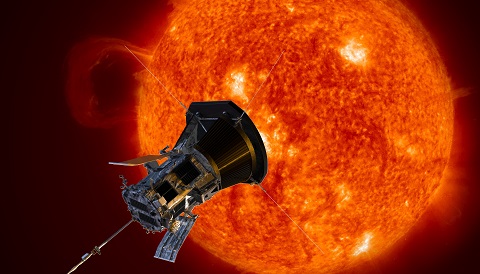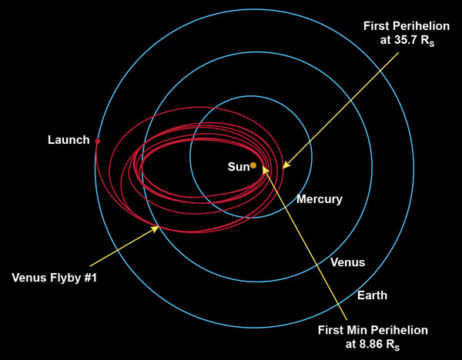Scientists release a bevy of results from the Parker Solar Probe's first two passes near the Sun.

As one solar mission — Solar Orbiter — lifted to the skies on Sunday evening, scientists released results (a whole lot of ‘em) from another mission to the Sun. NASA’s Parker Solar Probe has passed well within Mercury’s orbit four times now to explore the birthplace of the solar wind, a stream of charged particles that ultimately flow by and even onto Earth.
Scientists present results from the first two perihelion passes in a total of 52 articles in a special issue of the Astrophysical Journal Supplement Series. Those first passes took the spacecraft to within 0.16 astronomical units (a.u.) from the Sun’s surface, less than half the average distance to Mercury. These studies follow up on the preliminary results released in Nature last November, providing more details on the origins of so-called rogue waves, as well as the unexpectedly speedy rotation of the solar wind.
Finding the Source of Rogue Waves
Perhaps the biggest surprise to come out of Parker’s first passes near the Sun was the discovery of rogue waves, folds in the magnetic field that accompany surges of charged particles.

NASA / Conceptual Image Lab / Adriana Manrique Gutierrez
Other missions have seen these rogue waves for decades now, even though they didn’t come quite so close to the Sun. In fact, NASA’s Helios satellites saw rogue waves after they launched back in the 1970s. But by the number of other names scientists have used to describe rogue waves — such as jets, spikes, foldings, field reversals, deflections, and switchbacks — it’s clear that we don’t yet have a handle on the phenomenon.
Now, Parker’s observations are adding a closer-in view to the equation, showing the waves on a different scale. “The sheer number of them and the size of them is surprising,” says instrument scientist Tony Case (Smithsonian Astrophysical Observatory).
A number of studies in the special issue reveal additional details about the roughly thousand rogue waves detected during the first two passes by the Sun. The waves last between a fraction of a second to almost an hour, they tend to cluster together, and while they tend to involve a fold in the magnetic field, the direction of the fold is pretty much random. Multiple studies suggest that the rogue waves originate from deep within the corona, nearer the solar surface.
Successive orbits will take Parker as close as 10 solar radii (0.05 a.u.) from the Sun’s surface, so even if Parker never sees the actual origin of the rogue waves, it will see them in more of their original state, Case says.
Full Speed Ahead
Another result that surprised Parker mission scientists is the unexpectedly speedy rotation of the solar wind.
If you were to watch a movie of a solar prominence erupting out of the visible surface, you would see it rotate as if it were part of the Sun itself. Indeed, the Sun’s magnetic field keeps it anchored in place. Yet by the time solar wind plasma passes by Earth, it’s flying straight outward — generally, there’s no rotation at all. As Parker swooped near the Sun, scientists expected the solar wind to pick up its rotational speed. But as Justin Kasper (University of Michigan) and colleagues announced last November, the rotational speed turned out to be off the charts, peaking at speeds of 35 to 50 km/s (80,000 to 110,000 mph).
Now, two studies in the special issue attempt to reproduce this speed within their computer simulations — but as yet, they can’t. Victor Réville (UCLA and University of Toulouse, France) and colleagues used a simulation to show what was happening in the solar wind during Parker’s first encounter with the Sun. The simulation could reproduce most of the properties of the solar wind that Parker saw, such as its density and its outward (radial) velocity, but it failed to reproduce its fast rotational speed.
Solving this riddle may come back to the rogue waves, Réville and colleagues say, which temporarily but severely change the conditions of the solar wind. Scientists will need to study the problem further to see if rogue waves might be the answer.

NASA
Meanwhile, Parker is on its way out from its fourth and closest-yet perihelion pass on January 29th. This orbit took the spacecraft within 0.12 a.u., thanks to a gravity-assist maneuver on December 26, 2019, that sent Parker slingshotting around Venus. The orbits will only get closer and we’ll continue to delve into the new answers and questions Parker brings us.
 0
0









Comments
You must be logged in to post a comment.